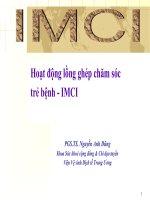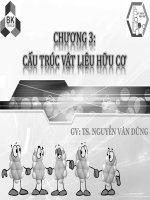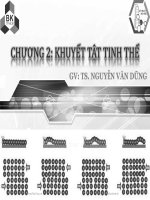- Trang chủ >>
- Đại cương >>
- Kinh tế vi mô
bài giảng kinh tế vi mô chương 3: độc quyền - ts. nguyễn tiến dũng
Bạn đang xem bản rút gọn của tài liệu. Xem và tải ngay bản đầy đủ của tài liệu tại đây (14.79 MB, 60 trang )
III.Monopoly
III. Độc quyền
Harcourt, Inc. items and derived items copyright © 2001 by Harcourt, Inc.
© 20 07 Thomson South-Western
Harcourt, Inc. items and derived items copyright © 2001 by Harcourt, Inc.
1. Monopoly
While a competitive firm is a price taker,
a monopoly firm is a price maker.
A firm is considered a monopoly if . . .
it is the sole seller of its product.
its product does not have close
substitutes.
Harcourt, Inc. items and derived items copyright © 2001 by Harcourt, Inc.
a. Why Monopolies Arise
The fundamental cause of
monopoly is barriers to entry.
a. Tại sao độc quyền lại xuất hiện?
Nguyên nhân cơ bản của độc
quyền là hàng rào gia nhập
Harcourt, Inc. items and derived items copyright © 2001 by Harcourt, Inc.
Why Monopolies Arise
Barriers to entry have three sources:
Ownership of a key resource.
The government gives a single firm the exclusive right to
produce some good.
Costs of production make a single producer more efficient
than a large number of producers.
Các hàng rào gia nhập phát sinh từ ba nguồn lực chính sau:
Nguồn lực then chốt thuộc quyền sở hữu của một doanh nghiệp
duy nhất.
Chính phủ giao cho doanh nghiệp nào đó đặc quyền sản xuất
một hàng hoá hoặc dịch vụ nhất định.
Chi phí sản xuất làm cho nhà sản xuất nào đó trở nên có hiệu
quả hơn so với các nhà sản xuất khác.
Harcourt, Inc. items and derived items copyright © 2001 by Harcourt, Inc.
Bằng sáng chế đăng ký tại Hoa Kỳ của
Việt Nam tính trên đầu dân cách đây vài
năm chỉ là hai so với hơn 1100 của Thái
Lan và hơn 40.000 của Trung Quốc.
Harcourt, Inc. items and derived items copyright © 2001 by Harcourt, Inc.
b. Natural Monopolies
An industry is a natural monopoly when a single
firm can supply a good or service to an entire
market at a smaller cost than could two or more
firms.
b. Độc quyền tự nhiên
Một ngành được coi là độc quyền tự nhiên khi một
doanh nghiệp duy nhất có thể cung ứng một hàng
hoá hoặc dịch vụ cho toàn bộ thị trường với chi phí
thấp hơn trường hợp có hai hoặc nhiều doanh
nghiệp.
Harcourt, Inc. items and derived items copyright © 2001 by Harcourt, Inc.
b. Natural Monopolies
A natural monopoly arises when there
are economies of scale over the relevant
range of output.
b. Độc quyền tự nhiên
Độc quyền tự nhiên xuất hiện khi có
kinh tế quy mô trong một khoảng biến
thiên thích hợp của sản lượng.
Harcourt, Inc. items and derived items copyright © 2001 by Harcourt, Inc.
Economies of Scale as a Cause of
Monopoly
Average
total
cost
Quantity of Output
Cost
0
Harcourt, Inc. items and derived items copyright © 2001 by Harcourt, Inc.
c. Monopoly versus Competition
Monopoly
Is the sole producer
Has a downward-sloping
demand curve
Is a price maker
Reduces price to increase sales
c. Độc quyền và cạnh tranh
Độc quyền
Là người sản xuất duy nhất.
Có đường cầu dốc xuống.
Là người định giá.
Giảm giá để tăng sản lượng
Competitive Firm
Is one of many producers
Has a horizontal demand curve
Is a price taker
Sells as much or as little at same
price
Doanh nghiệp cạnh tranh
Là một trong những nhà sx
Có đường cầu nằm ngang
Là người chấp nhận giá
Bán nhiều hoặc ít hàng hoá tại
cùng mức giá
Harcourt, Inc. items and derived items copyright © 2001 by Harcourt, Inc.
Quantity of
Output
Demand
(a) A Competitive Firm’s
Demand Curve
(b) A Monopolist’s
Demand Curve
0
Price
0 Quantity of
Output
Price
Demand
Demand Curves for Competitive and
Monopoly Firms
Harcourt, Inc. items and derived items copyright © 2001 by Harcourt, Inc.
a. A Monopoly’s Revenue
Total Revenue
P x Q = TR
Average Revenue
TR/Q = AR = P
Marginal Revenue
D
TR/
D
Q = MR
2. Profit Maximization of a Monopoly
Harcourt, Inc. items and derived items copyright © 2001 by Harcourt, Inc.
b. A Monopoly’s Total, Average, and
Marginal Revenue
Quantity
(Q)
Price
(P)
Total Revenue
(TR=PxQ)
Average
Revenue
(AR=TR/Q)
Marginal Revenue
(MR= )
0 $11.00 $0.00
1 $10.00 $10.00 $10.00 $10.00
2 $9.00 $18.00 $9.00 $8.00
3 $8.00 $24.00 $8.00 $6.00
4 $7.00 $28.00 $7.00 $4.00
5 $6.00 $30.00 $6.00 $2.00
6 $5.00 $30.00 $5.00 $0.00
7 $4.00 $28.00 $4.00 -$2.00
8 $3.00 $24.00 $3.00 -$4.00
QTR
DD
/
Harcourt, Inc. items and derived items copyright © 2001 by Harcourt, Inc.
A Monopoly’s Marginal Revenue
A monopolist’s marginal revenue is always less than
the price of its good.
The demand curve is downward sloping.
When a monopoly drops the price to sell one more
unit, the revenue received from previously sold units
also decreases.
Doanh thu biên của độc quyền
Doanh thu biên của nhà độc quyền luôn luôn ít hơn
giá cả của hàng hóa.
Đường cầu là đường dốc xuống.
Khi nhà độc quyền giảm giá bán của mỗi đơn vị sản
phẩm, doanh thu của những đơn vị sản phẩm được
bán trứơc cũng giảm giá.
Harcourt, Inc. items and derived items copyright © 2001 by Harcourt, Inc.
A Monopoly’s Marginal Revenue
When a monopoly increases the amount it
sells, it has two effects on total revenue (P x
Q).
The output effect—more output is sold, so Q is
higher.
The price effect—price falls, so P is lower.
Doanh thu biên của nhà độc quyền
Khi nhà độc quyền tăng lượng sản phẩm bán ra,
thì hành vi này gây ra 2 hiệu ứng đối với tổng
doanh thu (P x Q).
Hiệu ứng sản lượng —sản lượng bán ra nhiều hơn,
cho nên Q cao hơn.
Hiệu ứng giá cả —giá cả giảm, cho nên P thấp hơn.
Demand and Marginal Revenue Curves
for a Monopoly
Quantity of Water
Price
$11
10
9
8
7
6
5
4
3
2
1
0
-1
-2
-3
-4
1 2 3 4 5 6 7 8
Marginal
revenue
Demand
(average revenue)
Harcourt, Inc. items and derived items copyright © 2001 by Harcourt, Inc.
Harcourt, Inc. items and derived items copyright © 2001 by Harcourt, Inc.
c. Profit Maximization of a Monopoly
A monopoly maximizes profit by producing the
quantity at which marginal revenue equals
marginal cost.
It then uses the demand curve to find the price that
will induce consumers to buy that quantity.
c. Tối đa hoá lợi nhuận của nhà độc quyền
Nhà độc quyền tối đa hoá lợi nhuận bằng cách
lựa chọn mức sản lựơng mà tại đó doanh thu
cận biên bằng chi phí cận biên.
Sau đó sử dụng đường cầu để xác định mức giá
để người tiêu dùng mua hết mức sản lượng đó.
Profit-Maximization for a Monopoly
Monopoly
price
Quantity
Q
MAX
0
Costs and
Revenue
Demand
Average total cost
Marginal revenue
Marginal
cost
A
1. The intersection of
the marginal-revenue
curve and the marginal-
cost curve determines
the profit-maximizing
quantity
B
2. and then the demand
curve shows the price
consistent with this
quantity.
Harcourt, Inc. items and derived items copyright © 2001 by Harcourt, Inc.
Harcourt, Inc. items and derived items copyright © 2001 by Harcourt, Inc.
Comparing Monopoly and Competition
For a competitive firm, price equals marginal cost.
P = MR = MC
For a monopoly firm, price exceeds marginal cost.
P > MR = MC
So sánh độc quyền và cạnh tranh
Đối với doanh nghiệp cạnh tranh, giá bằng với chi
phí biên.
P = MR = MC
Đối với doanh nghiệp độc quyền, giá vượt chi phí cận
biên.
P > MR = MC
Harcourt, Inc. items and derived items copyright © 2001 by Harcourt, Inc.
A Monopoly’s Profit
Profit equals total revenue minus total costs.
Profit = TR - TC
Profit = (TR/Q - TC/Q) x Q
Profit = (P - ATC) x Q
Lợi nhuận của nhà độc quyền
The Monopolist’s Profit
Quantity0
Costs and
Revenue
Demand
Marginal cost
Marginal revenue
Q
MAX
B
Monopoly
price
E
Average
total cost
D
Average total cost
C
Harcourt, Inc. items and derived items copyright © 2001 by Harcourt, Inc.
Harcourt, Inc. items and derived items copyright © 2001 by Harcourt, Inc.
Nhà độc quyền không có đường cung.
Lý do?
Harcourt, Inc. items and derived items copyright © 2001 by Harcourt, Inc.
The Market for Drugs
M
ột ví dụ về sản phẩm độc quyền
và sản phẩm “nhái”
Costs and
Revenue
Price
during
patent life
Price after
patent
expires
Monopoly
quantity
Competitive
quantity
0
Quantity
Demand
Marginal
cost
Marginal
revenue
Harcourt, Inc. items and derived items copyright © 2001 by Harcourt, Inc.
3. The Welfare Cost of Monopoly
In contrast to a competitive firm, the monopoly
charges a price above the marginal cost.
From the standpoint of consumers, this high price makes
monopoly undesirable.
However, from the standpoint of the owners of the firm, the
high price makes monopoly very desirable.
3. Tổn thất phúc lợi do độc quyền
Khác với doanh nghiệp cạnh tranh, doanh nghiệp độc
quyền ấn định mức giá cao hơn chi phí cận biên.
Nhìn từ phương diện ngừơi tiêu dùng, mức giá cao này làm cho
người ta không muốn thấy tình trạng độc quyền.
Tuy nhiên, nhìn từ phương diện ngừơi chủ sở hữu doanh nghiệp,
mức giá cao lại làm cho người ta muốn có sự độc quyền.
Harcourt, Inc. items and derived items copyright © 2001 by Harcourt, Inc.
Price
0
Quantity
Marginal cost
Demand
(value to buyers)
Efficient
quantity
Cost to
monopolist
Value
to
buyers
Value
to
buyers
Cost to
monopolist
Value to buyers is greater
than cost to seller.
Value to buyers is less
than cost to seller.
The Efficient Level of Output









